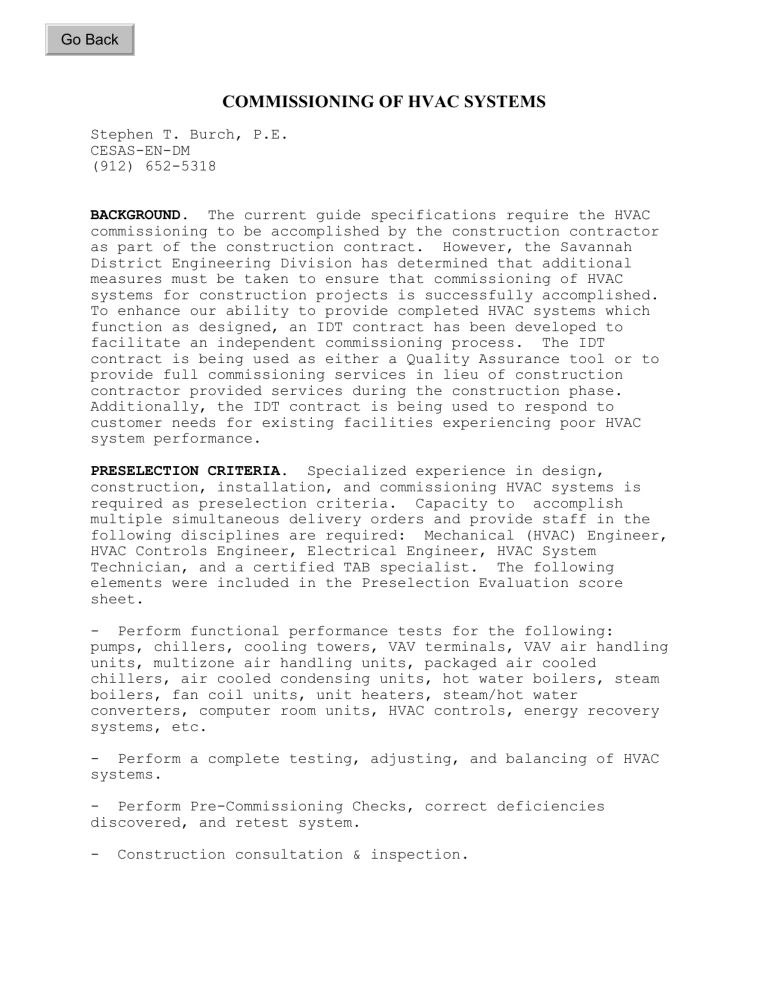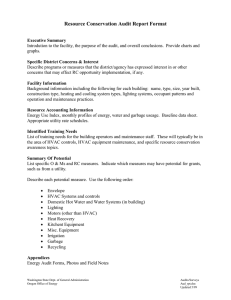commissioning of hvac systems

Go Back
COMMISSIONING OF HVAC SYSTEMS
Stephen T. Burch, P.E.
CESAS-EN-DM
(912) 652-5318
BACKGROUND . The current guide specifications require the HVAC commissioning to be accomplished by the construction contractor as part of the construction contract. However, the Savannah
District Engineering Division has determined that additional measures must be taken to ensure that commissioning of HVAC systems for construction projects is successfully accomplished.
To enhance our ability to provide completed HVAC systems which function as designed, an IDT contract has been developed to facilitate an independent commissioning process. The IDT contract is being used as either a Quality Assurance tool or to provide full commissioning services in lieu of construction contractor provided services during the construction phase.
Additionally, the IDT contract is being used to respond to customer needs for existing facilities experiencing poor HVAC system performance.
PRESELECTION CRITERIA . Specialized experience in design, construction, installation, and commissioning HVAC systems is required as preselection criteria. Capacity to accomplish multiple simultaneous delivery orders and provide staff in the following disciplines are required: Mechanical (HVAC) Engineer,
HVAC Controls Engineer, Electrical Engineer, HVAC System
Technician, and a certified TAB specialist. The following elements were included in the Preselection Evaluation score sheet.
- Perform functional performance tests for the following: pumps, chillers, cooling towers, VAV terminals, VAV air handling units, multizone air handling units, packaged air cooled chillers, air cooled condensing units, hot water boilers, steam boilers, fan coil units, unit heaters, steam/hot water converters, computer room units, HVAC controls, energy recovery systems, etc.
- Perform a complete testing, adjusting, and balancing of HVAC systems.
- Perform Pre-Commissioning Checks, correct deficiencies discovered, and retest system.
- Construction consultation & inspection.
- New military facilities requiring HVAC systems.
- Improvements and repairs to existing HVAC systems.
- Preparation of technical documentation which supports detail inspection, testing, adjusting, balancing, and trouble shooting of HVAC system designs and installed systems.
- Capacity to provide the following disciplines:
Mechanical Engineer (HVAC) 1
HVAC Controls Engineer
Electrical Engineer
HVAC Systems technician
1
1
1
KEY TECHNICAL AREAS . The HVAC Commissioning IDT contract can be used in the following applications: Performing functional performance tests for typical mechanical equipment, performing a complete testing, adjusting, and balancing of HVAC systems, performing Pre-Commissioning Checks, correct deficiencies discovered, and retest system, construction consultation & inspection, new military facilities requiring HVAC systems, improvements and repairs to existing HVAC systems, preparation of technical documentation which supports detail inspection, testing, adjusting, balancing, troubleshooting of HVAC system designs and installed systems, performing complete studies of
HVAC systems, and producing plans and specifications.
RESULTS TO DATE . Specific examples of IDT delivery orders issued during the spring and summer of 1997 have been documented and are presented as follows:
In April 1997 the first opportunity to use the IDT contract presented itself on the Alter Dormitories project at Seymour
Johnson AFB, North Carolina. The scope of work was developed for the first delivery order and negotiated.
1. Scope of Work: Subject dormitories have a four pipe heating and cooling system, with individual room Fan Coil units (FCU). A central energy plant provides chilled water and steam through distribution piping for eight dormitories. Steam is converted to heating water in the dormitory mechanical rooms. One air handling unit in each dormitory supplies conditioned (heated, cooled, dehumidified) air or makeup/fresh air to each room at the fan coil unit. The piping at the central chiller plant, for both chilled water and condenser/cooling tower water has been significantly changed through a contract modification to allow for the operation of the 4 pipe system during minimum demand
2
periods. Lack of enough heating and cooling capacity at the dorms was experienced. The IDT contract is being used to evaluate the contractor's TAB results. Specific activities included in the delivery order were the functional performance testing of:
- Pumps and piping from the chiller plant to four dormitory mechanical rooms.
- Cooling towers at the central chiller plant.
- Air Handling Units at each of four dormitories.
- Fan Coil Units in ten percent of all rooms in four dormitories.
- Steam/Hot Water Converters in four dormitories.
- HVAC Controls for AHUs, hot water for heat and chilled water
(dormitory side).
Using the results of the performance tests, system adjustments can then be made as required.
2. Through the use of the IDT a number of deficiencies in both the waterside and airside systems can be identified. By taking corrective action on each deficiency identified, the system performance should be enhanced. The original contract contained
HVAC commissioning requirements. However, the final TAB and commissioning could not be conducted until all the dormitories were completed and several modifications to the Central Energy
Plant could be incorporated. By the time this work was completed it was mid-October 1997. The Fall temperatures precluded any meaningful testing of the air conditioning systems. The construction contractor is scheduled to conduct the final TAB and commissioning during the coming air conditioning season.
Therefore, work under this IDT work order has been delayed until summer of 1998.
In May 1997 a delivery order was issued on the IDT contract to commission a study to determine the cause of insufficient cooling for the C-130 Aircraft operations and Logistic Facility at Pope
AFB, North Carolina. Numerous deficiencies were noted in the testing procedure.
1. Background Information. The C-130 Aircraft Operations &
3
Logistic Facility was designed in 1993 and constructed in 1994.
The building is approximately 2,035 square meters (21,900 square feet) in size. An exterior wall section consists of 100 mm
(4 inch) split face CMU, rigid insulation, 200mm (8 inch) CMU, metal furring channels and gypsum wall board. The roof is metal construction with engineered metal roof trusses. Roof insulation is attached to the bottom chord of the metal roof truss. The building layout includes general office/administrative areas with a Briefing/Conference Room, Operations Center, Ready Room, and
Storage/Support Room. The HVAC system serving the C-130
Operations & Logistics Facility consists of two medium pressure air handling units (AHU-3 and 4) supplying VAV boxes providing zone control of space temperatures. Each air handling unit is equipped with a chilled and hot water coil. Supply air quantity is controlled by a discharge damper in the supply duct. Each VAV box is equipped with a hot water reheat coil. Steam is provided from the base central steam system and is converted to hot water through a heat exchanger. Chilled water is provided to the system by a remote air cooled chiller. Typically, AHU-3 has a capacity of 2,775 Lps (5,880 cfm) with eight VAV boxes and serves the west half of the facility including offices, operations,
Ready Room, and Storage/Support. AHU-4, with a capacity of
3,840 Lps (8130 cfm), supplies seven VAV boxes and serves the east half of he building, including briefing and administrative areas. The facility is equipped with a full DDC temperature control system with a control panel for local access in the mechanical room. The North Carolina Area Office reported that most of the heating and cooling problems occurred in the areas served by AHU-3, especially the Ready Room and Storage/Support
Room. It was also noted that AHU-3 would not run continuously and required manual start on a daily basis. Inspection of the
Ready Room revealed it contains vending machines, microwave cookers, and computer work stations. The Storage/Support Room has roll-up door which is frequently used and the corridor between these two areas serves as a major entrance/exit for the building.
2. Testing Procedures. The IDT contractor was furnished a set of the design drawings and specifications, equipment submittals, and temperature control submittals for the project. A thorough review of these documents was performed to ensure conformity of submittals to contract documents and to assure the design reflected industry standards in HVAC systems. An access code was obtained from the installation temperature control engineer so the DDC system could be tapped at the building. Using this tap, operation of the system can be confirmed and also local readout of system operation can be obtained. The installation of the
4
HVAC system was then field verified to confirm that the equipment had been installed in accordance with the plans, specifications, and submittals. After confirmation, air and hydronic performance testing could begin. The original test and balance report was then reviewed to confirm as-built settings and air quantities.
The following procedure was used to test air handling systems
(AHU-3 and 4).
- Open all VAV boxes to full open through the DDC control system.
- Open the static pressure damper in AHU supply duct to gain maximum supply air out of the unit. Check outside air and return air dampers.
- Read all air devices to each VAV box with a flow hood and compare these readings to the DDC system.
- Adjust flow coefficients on each box through the DDC system to match actual air flow readings.
- Field verify the static pressure required to provide design cfm through the boxes. Reset this value into the DDC system.
- Set system back to automatic control by the DDC system (VAV boxes, discharge damper, outside, and return air).
- Check all air devices with flow hood and compare with DDC system.
- For heating cfm, the primary air was shut-off and the heating cfm was adjusted to the design quantity or minimum possible cfm using the fan speed controller.
The following procedure was used to test the chilled water system.
- Record the head pressure of the pump to determine the existing operating pumping head.
- Test pump to determine impeller curve. Set pump at design conditions.
- The chilled water pump only served the cooling coils in AHU-3
5
and 4. Each coil was equipped with a circuit setter and automatic flow control valve. After the pump was energized, the flow to each coil was checked at the circuit setter and by pressure drop through the coil.
- Quantity of flow was not verified through the chiller as pressure taps were not available.
The hot water pump was tested to determine impeller curve and the pump was set at design conditions (at the pump discharge only).
3. Deficiencies Noted.
- The HVAC design was marginal. If the system was operating in accordance with the design, the building would likely be uncomfortable under certain conditions. Low air flow was determined to be the primary problem.
- The allowable pressure drop across the VAV boxes of 250 Pa
(1.0 inch static pressure) is higher than normal design standards and exceeds the manufacturer's recommendations.
- Sufficient static pressure is not available to distribute the secondary air from the VAV box to the air devices. The external static pressure of 375 Pa (0.15 inch) was considered inadequate for the system as designed. The heating air flow delivered by the VAV fan box was often higher than the required flow due to inadequate pressure at the VAV box flow sensor.
- The ductwork was not installed as originally designed due to lack of ceiling space. The VAV boxes were located in the ceiling cavity and the primary and secondary air distribution was routed in the attic area. This configuration created additional static pressure due to four additional elbows required to actually install the ductwork in the available space.
- In order to increase the air volume from the air devices, the fan operating speed was increased causing high static pressures in the system. As a result, duct leakage increased (16%) as ductwork designed and built for 500 Pa (2 inches water column) is now operating at 1,250 Pa (5 inches water column). With the increase in fan speed, more energy is introduced into the supply air. A 3.3 degree C (6 degree F) temperature rise over the fan was noted, thus the coolest supply air temperatures would be
12.2 + 3.3 = 15.5 deg C (60 degrees F).
- For AHU-3 the duct static pressure sensor was not working
6
correctly and needed to be replaced. The sensor should have been located in the mechanical room. Due to the higher operating speed of AHU-3, the existing 10 HP motor is experiencing high current draw, and shuts off after several hours of operation due to thermal overload. The heating coil control valve motor was not working for AHU-3.
4. Recommendations.
- The majority of the heating and cooling problems and complaints are associated with the areas served by AHU-3.
Several changes have been made to the system since design and installation including providing rigid ducts between the primary air ducts and VAV boxes and lowering the chilled water supply temperature from the chiller. These were marginal "fixes" and did help the overall efficiency of the unit. AHU-4, although operating at 85% design capacity, appears to be providing sufficient heating and cooling for the area it serves. None of the modifications made to AHU-3 were made to AHU-4. Thus, for the purpose of the report, only recommendations for system served by AHU-3 were considered. Presently, the cooling coil and fan are the largest size components that can physically fit in the air handling unit casing. However, the number of rows of the cooling coil can be increased. The fan is operating at or near maximum RPM and static pressure capacity, therefore, neither can be increased.
- To improve the heating and cooling conditions in the areas served by AHU-3, two options were developed. Option No. 1 provided for the replacement of the existing chilled water coil, in AHU-3, new 15 HP fan motor, replacement of 6 VAV boxes and two new split system heat pumps, one each for Ready Room 147 and
Support/Storage Room 146. Estimated cost: $54,625.00. Option
No. 2 provided for the replacement of AHU-3 with a new unit, new chilled water pump, and two new split system heat pumps, one each for Ready Room 147 and Support/Storage Room 14.
Estimated cost: $55,750.00.
- Conclusion: The cost for Option No. 1 and No. 2 are nearly equal. Either option is acceptable. Option No. 2 was recommended by the IDT contractor since the fan motor for the new
AHU-3 would operate with a 10 HP motor instead of a 15 HP motor as required by a coil change. Over the life of the system,
Option no. 2 would have lower energy and operating costs. Based on this study, the Construction Field Office opted to install two new split system heat pumps (consisting of a condensing unit outside the facility and a heat pump mounted above the ceiling),
7
one each for both the Ready Room 147 and Support/Storage
Room 146. By removing these two rooms from the original HVAC system, the remaining loads can be more efficiently satisfied.
The dedicated stand alone split system heat pumps will satisfy the load demand for each of the two rooms identified. A pressure sensor originally located in the attic was relocated to the mechanical room as recommended by the IDT contractor.
PLANS FOR THE FUTURE
Savannah District plans to continue the use of the HVAC
Commissioning IDT contract as a viable tool to enhance our ability to ensure HVAC systems are designed, constructed, operated, and maintained effectively. The quality of life of our military personnel continues to be a major focus of the DoD and the senior military leadership at each installation. HVAC system components, particularly controls, continue to be more sophisticated, further challenging designers, construction personnel, the base operation and maintenance staff, and the facility occupants. Quality Control and Quality Assurance of
HVAC systems begins as each project design is initiated, through the conceptual, preliminary, and final design stages, and culminating with the advertising and award of the construction contract. However, the acid test really begins with building occupancy and the transfer of the constructed facilities, to include HVAC systems to the installation operation and maintenance representatives. At the preconstruction conference, the area and resident engineers and their staff must set the tone with the general contractor and his subcontractors emphasizing the critical importance of a deliberate HVAC commissioning process to ensure success. Beginning with the shop drawing submittal approval process, each system component, both airside and waterside, must be carefully reviewed keeping in mind the overall system configuration. Continuing inspection of work as it is progresses and effective communication with contractor and subcontractor representatives is very important. Testing of subsystems and components as they are installed and completed is critical. Insisting on meaningful TAB of systems witnessed by our construction representatives is a must. Follow up to ensure deficiencies identified in the TAB results are effectively corrected helps ensure the completed system will function as designed. Effective communication between our construction field personnel and the installation operation and maintenance staff cannot be over emphasized. If the customer who is responsible for operating and maintaining HVAC systems is not familiar with each system, there is little doubt that problems will occur. Our customers at the installation must be participating members of
8
the HVAC commissioning team. By including the designer, the corps of engineers construction representative, the contractor and his subcontractors, and the installation operation and maintenance personnel, all the players who have a vested interest in assuring that the system is functional have an opportunity and a responsibility to participate. The HVAC IDT contract is a multifaceted tool which can be used to provide QA, QC in lieu of the construction contractor, to trouble shoot "sick" buildings, or to produce studies, and create HVAC designs. Although the
HVAC commissioning IDT contract is not a cure all, it can be an effective tool to assist us in ensuring the HVAC systems we design and install will be functional, reliable, and provide a comfortable environment for our military and civilian personnel who occupy the facilities.
9

